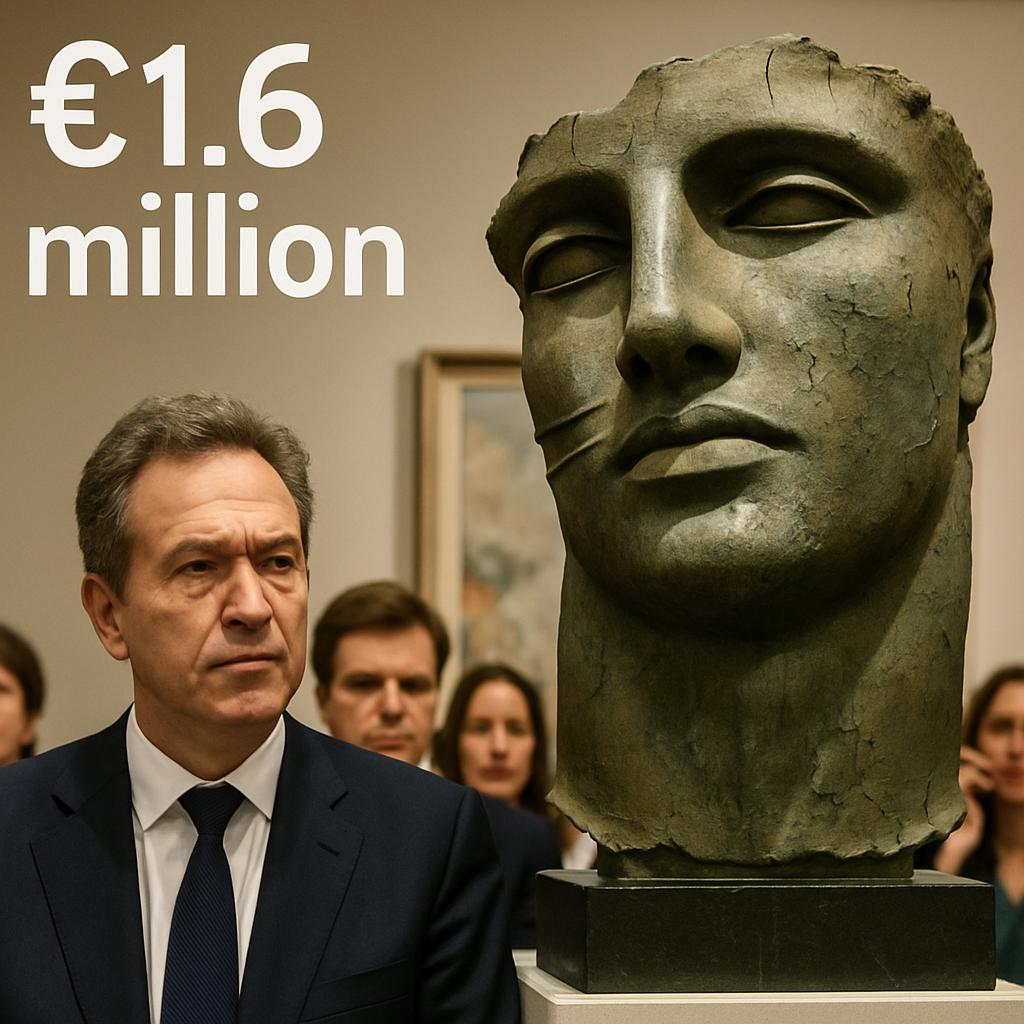When a single object rearranges the map of a market, you notice the tremor: collectors whisper, galleries recalibrate, and artists get a new lease on recognition. That’s what happened recently when Mitora’s “Tindaro” sold at auction for a record €1.6 million, an outcome that did more than set a number — it shifted perception. The sale illuminated how reputations, rarity, and timing can collide to lift a work far beyond earlier estimations.
- What the sale tells us about Mitora’s standing in the art world
- A closer look at “Tindaro” — form, subject, and why it resonated
- Provenance, condition, and exhibition history: the invisible price drivers
- How auctions create moments
- Who was bidding — the visible and the invisible participants
- Comparisons with previous market records
- Table: snapshot of relevant auction metrics
- Why collectors were willing to push the price
- Institutional interest: museums and the public dimension
- What this means for galleries and future exhibitions
- Advice for collectors in the wake of headline sales
- The role of the media and social networks in accelerating a sale’s impact
- Longer-term implications for Mitora’s career
- Market analysts weigh in: sustainability versus speculation
- Practical considerations for owners thinking of selling
- The cultural ripple: why public recognition matters
- Personal note: why I pay attention to moments like this
- For the curious buyer: how to follow the unfolding story
What the sale tells us about Mitora’s standing in the art world

Mitora was already getting attention for a steady string of critically received shows, but this auction elevated the artist from promising to headline-making. Achieving a seven-figure price at public sale tends to harden an artist’s market: museums take another look, dealers reset prices, and private buyers reassess scarcity. In short, the sale offers a new benchmark against which future works will be measured.
Market entries like this one also affect the narrative around an artist’s oeuvre. Works that had been trading quietly in private hands may now be catalogued as investments rather than house decorations. That shift doesn’t only change how people buy; it alters how curators select and how critics write, since high-value sales inevitably draw renewed scholarly attention.
A closer look at “Tindaro” — form, subject, and why it resonated
“Tindaro” combines a disciplined formal language with emotional undercurrents that reward repeated viewing. The composition balances subtle geometry with a tactile surface treatment that reads differently in morning light than it does in a gallery’s cool LEDs. Collectors told auction-room reporters that the painting’s tension — restrained yet volatile — made it stand out among the evening’s lots.
Art that compels bidders usually does so for layered reasons: visual strength, documented rarity, and a story collectors can tell about ownership. “Tindaro” offered all three. Its painterly decisions created immediate aesthetic drama, while its exhibition history and provenance supplied a narrative that buyers felt comfortable investing in. That combination translated into vigorous bidding and the record price we’re now discussing.
Provenance, condition, and exhibition history: the invisible price drivers
Provenance matters more than many outsiders realize; a solid ownership trail reassures buyers. The work’s documented presence in several respected private and public collections provided a kind of underwriting for bidders. Condition reports also played a role — the lot came to auction with a clean report, which removes a common concern that can suppress prices at the dial.
Exhibition history amplifies value when the work has been included in influential shows or cited in academic catalogs. Each institutional endorsement functions like a vote of confidence. For “Tindaro,” the chain of exhibitions and published references helped convert aesthetic admiration into monetary commitment at the sale.
How auctions create moments
Auctions aren’t just marketplaces; they’re theatrical events. The pace of bidding, the brief hush before a hammer falls, and the pulses of surprise when estimates are trounced — all of it is part of a ritual that transforms private desire into public record. A sale like this one becomes a headline because a lot of people see the number and recalibrate what they thought possible.
For dealers and collectors alike, the spectacle matters because it produces data: comparable prices used for valuations, insurance, and estate planning. Public sales are the raw material of the art market’s price architecture, and a standout result can ripple through galleries and private sales for months afterward.
Who was bidding — the visible and the invisible participants
Not every player in the room is named at the final tally, and many successful bids are placed by phone or online. Institutional buyers, blue-chip private collectors, and opportunistic new entrants all can be present in different guises. The anonymity of some buyers means the record sale tells us about demand more than it tells us about ownership.
It’s also worth noting the role of specialists and advisors. Experienced advisors read the room and set strategic bids; they translate an institution’s or client’s broader aims into action. The presence of high-caliber representation often intensifies competition rather than dampening it, because bidders know they’re facing informed opponents.
Comparisons with previous market records
To grasp the significance of this €1.6 million figure, it helps to compare it with prior benchmarks in Mitora’s market and with peers. If earlier highs were clustered in the low six figures, then crossing the million-euro threshold is a leap, not a step. For collectors who track trends, that gap signals both a new ceiling and a possible acceleration of secondary-market prices.
Comparisons with contemporaries can be as revealing as comparisons with the artist’s own past. When a single work outperforms similar artists’ top results, it changes relative rankings. Museums and collectors take these shifts seriously because they affect acquisition strategies and the perceived scarcity of comparable works.
Table: snapshot of relevant auction metrics
The table below summarizes key details about the sale and contextual metrics often used by market analysts. These figures are typical markers that collectors consult when assessing value and risk.
| Metric | Detail |
|---|---|
| Artist | Mitora |
| Work | “Tindaro” |
| Sale price | €1.6 million (hammer/record) |
| Estimate range | Estimated pre-sale ranges were outstripped by the final bid |
| Buyers | Details not publicly disclosed |
Why collectors were willing to push the price
Several motivations drive buyers to surpass estimates: cultural capital, investment potential, and the desire to secure a work that might rarely appear on the market again. In that competitive frame, owning “Tindaro” is not merely about decoration; it’s about acquiring a piece that now has an authoritative market standing. For some bidders, the painting’s ascendancy is a validation of personal taste; for others, it’s a potential financial play.
Another factor is the psychology of scarcity. When a work represents one of a small number of seminal pieces by an artist in a given period, bidders often act as if a window is closing. That urgency can force prices beyond what standard appraisals might suggest, especially when multiple motivated parties are present.
Institutional interest: museums and the public dimension
Museums don’t usually compete in the same way private collectors do, but high-profile sales can spur interest from public institutions seeking to fill narrative gaps in their collections. If a museum acquires a work after an auction, the provenance and visibility of the purchase can further canonize the artist. Conversely, when museums abstain, the result still matters because the sale becomes a reference point for exhibitions and scholarship.
Whether a museum participates often depends on acquisition budgets and strategic priorities. A sudden seven-figure price can put a work beyond many institutional reaches, which then shapes how that artist’s work circulates — more in private hands and less in public galleries, at least for the immediate future.
What this means for galleries and future exhibitions
Galleries that represent the artist will likely see increased demand and leverage. They may raise price floors for new work and become more selective in their distribution strategies. This change can energize the artist’s production but also introduce pressures: expectations for larger, more ambitious pieces and for clearer provenance documentation.
Exhibitions may be arranged to capitalize on renewed attention, combining newly produced work with earlier pieces to tell a clearer story of development. Curators and gallery directors will use the sale as a narrative device because it helps attract audiences and press coverage, which in turn can justify higher asking prices in subsequent sales.
Advice for collectors in the wake of headline sales
For buyers watching the market, headline auctions like this one are both opportunity and cautionary tale. If one acquires art as an investment, it’s critical to consider liquidity: not all works that achieve high prices at auction will appreciate consistently. Diversification and deep knowledge of an artist’s catalog remain essential risk-management strategies.
Provenance, condition, and the artist’s production patterns should inform any new purchase. I’ve attended auctions where excitement alone drove prices beyond reasonable estimates, and I’ve also seen the market correct itself. Patience and rigorous due diligence help collectors make choices that aren’t solely swayed by headline numbers.
The role of the media and social networks in accelerating a sale’s impact

Media coverage amplifies every notable sale, sometimes creating feedback loops that push attention onto related works. Social media, with its accelerated news cycles and shareable visuals, can turn a single auction lot into a viral moment. That visibility increases demand, but it also subjects the market to fashions that may be short-lived.
When a sale becomes talk online, younger collectors who follow trends may join the market in earnest, which reshapes demographics and bidding behaviors. The result is a marketplace that’s both more dynamic and more volatile, where informed long-term collectors coexist with trend-driven entrants.
Longer-term implications for Mitora’s career
Achieving a headline price can be a turning point in an artist’s career, opening doors to larger institutional loans and higher-profile retrospectives. Yet, it can also raise expectations in ways that complicate an artist’s creative trajectory. The pressure to produce work that meets market appetite can be palpable, but many artists use this newfound attention as fuel for experimentation instead of repetition.
In short, the sale offers a stage and some breathing room. How Mitora navigates that stage — whether by deepening the work’s intellectual ambitions or by engaging new audiences — will determine whether this auction is a single peak or the start of a sustained ascent.
Market analysts weigh in: sustainability versus speculation
Analysts will watch upcoming sales of Mitora’s work to determine if this result represents a durable market shift or a momentary spike. If subsequent public offerings approach or surpass the new benchmark, the €1.6 million figure will look less like an outlier and more like an emergent standard. Sustained interest across different venues and price points typically signifies a more stable market.
Speculative spikes are common in art markets; they can be driven by a single well-funded bidder’s enthusiasm. That’s why transparency in auction outcomes and subsequent private sales is important for assessing whether a price is likely to hold. Over time, traceable sales form the best evidence of market direction.
Practical considerations for owners thinking of selling
If you own a piece by an artist who just enjoyed a headline sale, timing and presentation matter. Sellers should secure up-to-date condition reports, consider professional photography for catalogs, and consult multiple auction houses or dealers to weigh the best route to market. Marketing strategy — emphasizing provenance, exhibition history, and scholarly citations — can materially affect final price.
It’s also important to consider tax and estate implications; high-value transactions bring different legal and financial obligations. Working with advisors who understand the art market minimizes surprises and helps align sale timing with broader financial plans.
The cultural ripple: why public recognition matters
Beyond dollars and cents, such a sale expands the cultural conversation around an artist’s work. Critics write; students study; galleries ask for loans. That attention can enrich the artist’s place in art history and broaden public access through exhibitions and publications. When a piece publicly achieves prominence, it tends to re-enter academic and curatorial cycles in consequential ways.
That ripple effect is one reason why collectors sometimes view acquisitions as civic gestures as well as private investments. Museums and institutions benefit from the heightened visibility, and the public gains new opportunities to engage with the work in ways that weren’t possible before the auction made headlines.
Personal note: why I pay attention to moments like this
I’ve covered art markets for years and attended auctions where a single lot changed the tenor of an evening. Those experiences taught me that a sale is not just the end of a transaction but the start of a conversation that can last for months or years. Observing how collectors, curators, and critics respond in the aftermath reveals more about our cultural priorities than any single price tag can.
That perspective matters because it underlines the difference between short-term excitement and lasting significance. When a work like “Tindaro” draws such attention, the real test comes in how the community integrates that moment into longer narratives about art and value.
For the curious buyer: how to follow the unfolding story
If you want to track how this sale changes the market, keep an eye on subsequent auctions, gallery inventories, and institutional acquisitions involving the artist. Auction house reports, catalog raisonné updates, and academic publications will be the most reliable indicators of whether the result signifies a structural change. Subscribing to reputable market analyses and art journals will also keep you informed.
Attending viewings and speaking directly with dealers and advisors are practical steps for anyone considering a purchase. Those conversations reveal subtleties that price lists and headlines do not, such as edition sizes, related works in private hands, and emerging curatorial interest.
If this story piqued your interest, explore our other coverage for more analysis and market insight. Visit the Technology & Innovation News section at https://themors.com/technology-innovation-news/ for related articles that put market moments like this in broader context.
For additional features and continuing coverage, check out our full website at https://themors.com/. You’ll find in-depth reporting, market briefings, and expert commentary to help you follow developments in art, technology, and culture.









